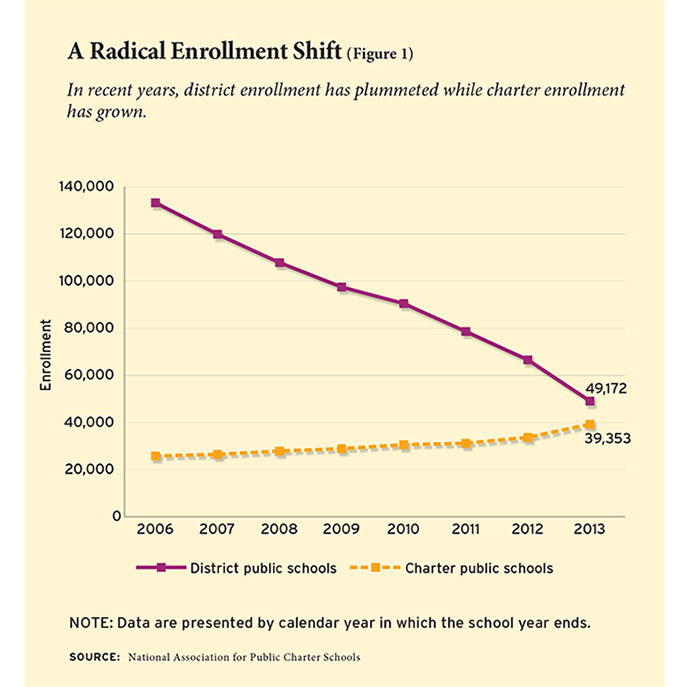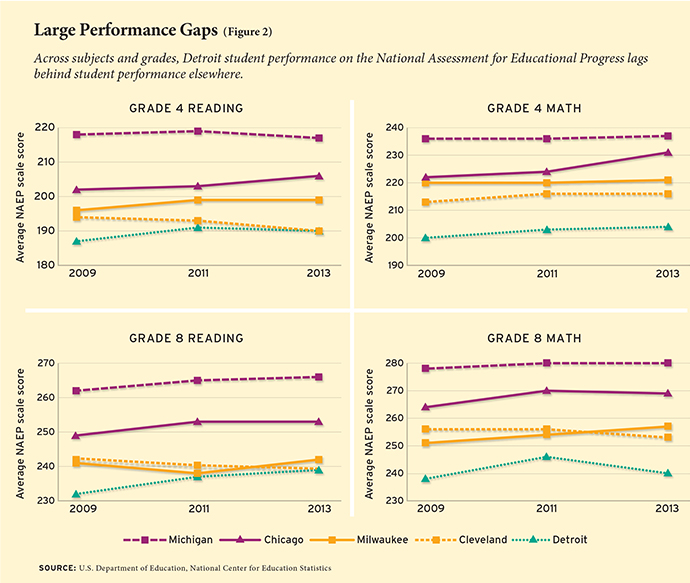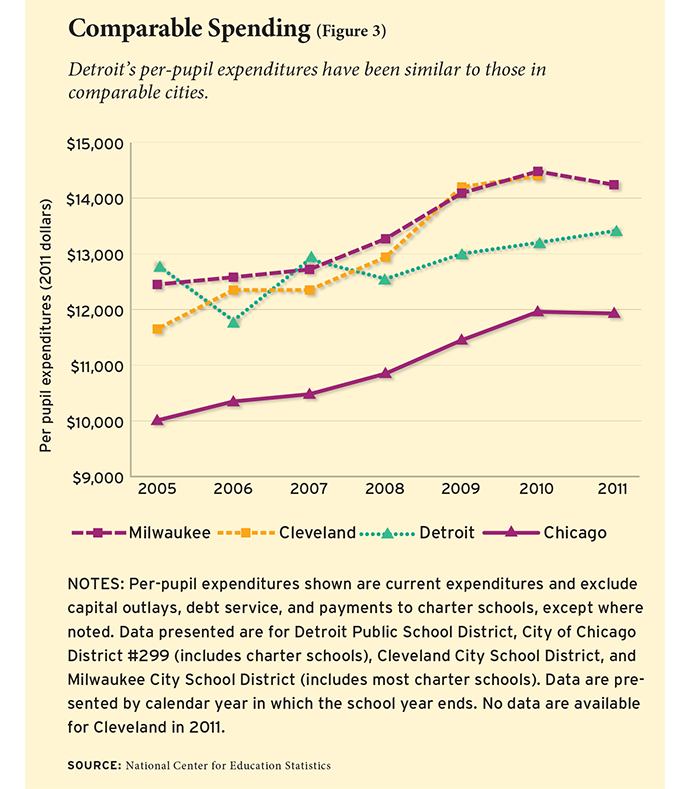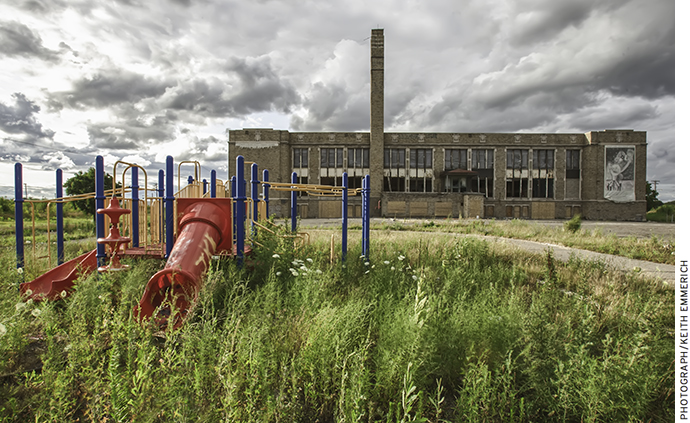Detroit is a classic story of a once-thriving city that has lost its employment base, its upper and middle classes, and much of its hope for the future. The city has been on a long, slow decline for decades. It’s difficult to convey the postapocalyptic nature of Detroit. Miles upon miles of abandoned houses are in piles of rot and ashes. Unemployment, violent crime, and decades of underinvestment have led to a near-complete breakdown of civic infrastructure: the roads are terrible, the police are understaffed, and there is a deeply insufficient social safety net.
There are new federal funds and private investment being directed to Detroit’s renewal. Bankruptcy proceedings are finally under way, and a new mayor wants to make a fresh start. But it’s hard to see how a renaissance can occur without making headway on the public schools. Detroit parents still have very few high-quality options, despite a number of different reform interventions, including putting a state-appointed emergency manager in charge of the district, pulling the lowest-performing schools into a statewide turnaround district, and allowing a significant number of charter schools to operate.
In January 2014, as part of a multicity study, researchers from the Center on Reinventing Public Education (CRPE) met with a dozen parents in Detroit to learn about their experiences with education in the city. What follows is one of many similar stories we heard.
Ms. Gordon (not her real name) is a lifelong Detroit resident. Her 11-year-old son will enter middle school in the fall of 2014, and she is anxious about how to find and choose his next school. He has not had an easy time in elementary school; he struggled academically and was often in trouble for his behavior. Over the years, she has tried to talk to the principal and her son’s teachers, but it always felt as though no one was listening to her concerns or willing to work with her to address them. Now, as she’s looking for a middle school, she wants her son to have a fresh start and a chance to get the academic and social support that he needs. A friend suggested she look at the charter school that her daughter attends. The school sounded interesting, but Ms. Gordon decided it was too far away for her son to travel there safely on his own. Even if she could find a safe route, she was disappointed to read in a parent guide [published by Excellent Schools Detroit] that the kids at the charter school weren’t doing any better than those at the low-performing neighborhood middle school. In fact, few schools looked like good options, even though there were many to choose from. As she faced spring enrollment decisions at the time we talked to her, she felt she was no closer to finding a school that would be a good fit for her son. She expressed frustration and despair, recounting her efforts: “It just feels like you have to fight for your kids every day in this city, because no one else will.”
Today, Detroit is a “high-choice” city. Families choose from among charter schools, magnet schools, district schools, and schools in nearby districts. In Michigan, public universities, community colleges, intermediate school districts, and all traditional K–12 districts, called “sponsors,” can authorize an unlimited number of charter schools in Detroit and elsewhere in the state. The city’s charter sector expanded rapidly between 2010 and 2013; 32 new schools opened, a 42 percent increase in just those three years, bringing the total number to 109. By percentage of total enrollment, Detroit has the third-largest charter sector in the country, after New Orleans and Washington, D.C. As of the 2012–13 school year, nearly as many children attend charters (39,353) as attend Detroit’s district schools (49,172) (see Figure 1). Other Detroit families, around 14 percent, take advantage of Michigan’s interdistrict choice law that allows them to send their children to nearby suburban schools. Both Detroit’s charter and traditional public-school sectors serve predominantly African American families (roughly 85 percent) with limited economic resources (in charters, 84.5 percent qualify for free or reduced-price lunch versus 81.6 percent in district schools).
In Detroit, as was the case in the other cities we studied, parents struggle to navigate the city’s complex education marketplace and find quality options for their children. For parents like Ms. Gordon, a lack of information, confusing paperwork, and transportation gaps all make it hard to find a school that will work for their child. Parents told us you have to be a “fighter” if you want to find a good school in Detroit—no one is there to help. If parents like Ms. Gordon have a tough time, imagine those who do not speak English or have a student with disabilities. “There are no watchdogs in Detroit to make sure parents [of children with special needs] get what they need from schools,” said a charter school leader. “They’re on their own.”
School Choice with Few Options
Between 2005 and 2012, Detroit Public Schools (DPS) lost two-thirds of its enrollment or more than 84,000 students (see Figure 1). Most of these enrollment losses are a result of the city’s larger economic decline and the corresponding departure of residents. With a dwindling student population and an expanding array of education options, Detroit’s schools are in an all-out battle for students. The challenges of navigating choice in Detroit are made more complicated by this hypercompetitive environment. Some estimate there are currently 20,000 to 30,000 more seats than students in the city’s traditional and charter schools. A parent advocate called the competition for students a “snatch and grab.” A district official likened it to “guerrilla warfare,” with door-to-door battle plans for student recruitment. Competition between schools is so fierce that charter schools in the same charter network say they sometimes fight over students. Other school leaders say they worry about fending off schools that might open nearby.

Poor performance plagues schools in both DPS and the city’s large charter sector. Excellent Schools Detroit (ESD), a coalition of philanthropic, education, and community leaders, began grading publicly funded schools based on school climate and academic performance data in 2012. ESD gave just 16 percent of the city’s public schools (district or charter) a C+ or better in 2014, based on a combination of academic status, progress, and school climate measures. While the city has more than 250 schools, the city’s Eastside and Westside neighborhoods have just 10 high-quality K–8 programs between them; some neighborhoods have no schools with a passing grade.
Scores on the National Assessment for Educational Progress have been impossibly low since 2009; just 4 percent of 4th-grade students were proficient in math and 7 percent in reading in 2013. The results put the district far behind other urban school districts, and behind even other midwestern industrial cities like Cleveland and Chicago (see Figure 2).

Charter schools offer slightly more hope than traditional district schools. According to a 2013 report by the Center for Research on Education Outcomes (CREDO) at Stanford University, based on 2011 data, nearly half of Detroit’s charter schools outperform district schools, but given the very low bar set by the district, that’s not too difficult. The other half of Detroit’s charter schools have outcomes that are statistically indistinguishable from the city’s poorly performing traditional district institutions. It bears noting that these charter results are significantly better than the national average CREDO reported in 2009, in which just 17 percent of charter schools in the 16 states they studied performed better than their district counterparts.
The CREDO analysis also shows that Michigan’s low-income students, who comprise the vast majority of charter students in Detroit, make modest achievement gains (less than a month of additional learning in math each year) compared to district schools, as do black and Hispanic students.
Another study, by Michigan’s Mackinac Center for Public Policy, found positive, but by their admission “not great,” results: Detroit charter high schools performed somewhat better than predicted based on their socioeconomic makeup, while Detroit Public Schools performed worse than predicted.
Even Michigan charter advocates have trouble defending the overall state of charter quality. Many told us there were too many low-performing charter schools in Detroit and struggled to name any Detroit charter schools that are getting results like those achieved by national nonprofit charter management organizations. No high-performing national CMOs operate in the city. The incoming head of one of Detroit’s most well-regarded charter school networks told us that he thought his schools had a long way to go academically and had trouble attracting students.
The dearth of high-quality options is evident to parents. Nearly half of Detroit parents surveyed in March 2014 (48 percent) believe they would have a hard time finding another good school if their current school closed. Nearly half (45 percent) said that it was difficult to find a good fit for their child.
Navigation Trials
Parents in Detroit confronted more barriers to choice than those in any other city in our sample: they cite safety issues, lack of transportation, and lack of information as serious barriers to finding a good school. Nearly 40 percent of surveyed parents say they have trouble knowing whether their child is eligible for different schools, compared to 33 percent for all eight cities in which we administered the survey. About one-third of parents say that finding transportation and information about schools made choosing harder, which is again worse than we found in the average city. In Detroit, as elsewhere, information barriers are higher for parents with little education and for those whose children have special needs.
 Though many disadvantaged parents in Detroit are actively choosing a school for their child (55 percent of parents with a high school education), parents with the least education are much less likely than parents with college degrees to say their child is in a school that was their first or second choice (57 percent of parents with a high school education or less were in their top choice compared to 80 percent of those with a bachelor’s degree or more). Parents whose children have special needs are much less likely than parents of students in regular education to say their child is in a school that was their first or second choice (58 percent versus 74 percent).
Though many disadvantaged parents in Detroit are actively choosing a school for their child (55 percent of parents with a high school education), parents with the least education are much less likely than parents with college degrees to say their child is in a school that was their first or second choice (57 percent of parents with a high school education or less were in their top choice compared to 80 percent of those with a bachelor’s degree or more). Parents whose children have special needs are much less likely than parents of students in regular education to say their child is in a school that was their first or second choice (58 percent versus 74 percent).
Students with special needs are less likely than their peers to avail themselves of school choice options. These students are much more likely to attend Detroit’s traditional public schools than charters: 18 percent of DPS students have IEPs compared to 10 percent in charter schools. And while there are a variety of reasons this gap may exist, parents and others we interviewed told us that the proportion of IEP-eligible students in DPS is growing rapidly in large part because a number of Detroit charter schools simply don’t offer many special-education supports.
One community leader summed up the situation this way:
Detroit’s marketplace is as unregulated and unmanaged as any in the country, and tilts strongly toward favoring the supply side. It’s like a flea market…anyone can set up a table to sell their magic, and anyone can come shopping and make a deal, but buyer beware. In Detroit, more parents exercising choice has not resulted in better schools, and more charter schools has not resulted in better choices.
“The market is saturated,” a charter school leader confirmed, “but they keep on coming, and no one is shutting down the bad ones.”
Wanted: An Education Leader
Whose job is it to fix the problems facing parents in Detroit? Our interviews with leaders in the city suggest that no one knows the answer. It is not the state, which defers oversight to local education agencies and charter authorizers. It is not DPS, which views charters as a threat to its survival. It is not charter school authorizers, who are only responsible for ensuring that the schools they sponsor comply with the state’s charter-school law. It is not the mayor, who thus far sees education as beyond his purview. And it is not the schools themselves, which only want to fill their seats and serve the children they enroll.
No one in Detroit is responsible for ensuring that all neighborhoods and students have high-quality options or that parents have the information and resources they need to choose a school.
“It’s a free-for-all,” one observer said. “We have all these crummy schools around, and nobody can figure out how to get quality back under control…. Detroit hasn’t set the conditions to make school choice work for families and kids.”
Only one of Detroit’s charter authorizers is local—DPS, which authorizes 13 schools; the rest are colleges and universities with headquarters outside of the city. Each sponsor has different standards for approving and closing schools, and the quality of their schools varies widely. Unfortunately, there are few incentives and little capacity for improving the city’s charter schools. State law allows charter authorizers to retain 3 percent of the state funding for the schools they sponsor, creating a strong disincentive for closing schools. The state has the authority to close schools and revoke an authorizer’s license but has never used it. According to data from the National Alliance for Public Charter Schools, 12 of Detroit’s charter schools closed between 2010 and 2013. Among these closures, just five were related to academic performance.
Authorizers are free to open schools wherever they choose, regardless of need, and to allow poor-performing schools to remain open. In 2012, the legislature seemingly weakened its oversight of the charter sector by eliminating a requirement that the state education agency report on charter school quality each year. At the local level, few schools or authorizers are willing to do anything that might threaten their ability to attract and retain families.
Poor quality and a lack of incentives for improvement extend to the traditional district schools as well. Our interviews with DPS officials make clear they view the district’s problems in terms of marketing and customer service, rather than school quality. A visit to the district’s web site for enrollment reveals numerous materials touting the quality of district schools. But if parents want to find information on school performance or climate, they need to look elsewhere.
The Education Achievement Authority (EAA) of Michigan, a state agency, in 2011 took over 12 schools and now oversees 15 schools in Detroit, including 3 charter schools. The most intensive EAA schools run 210 days a year and employ a blended learning model. Results reported thus far have been mixed: an analysis of 2013 cohort data by Wayne State University professor Thomas C. Pedroni found that the majority of EAA students failed to demonstrate progress toward proficiency on the state’s assessments in reading and math, and some students’ performance (approximately one-third) declined. Yet according to Excellent Schools Detroit, in its first year, six of EAA’s K–8 schools scored in the top 20 for growth out of 127 schools rated.
Detroit Needs a Plan
Detroit is a powerful illustration of what happens when no one takes responsibility for the entire system of publicly supported schools in a city. Parents struggle to navigate their many, mostly low-performing options, and providers face at best weak incentives to improve academic quality. As a result, large numbers of failing district and charter schools continue to operate.
Still, hope is not lost. Many parent groups, nonprofits, and foundations in the city are working to step in where government has failed. Civic groups and leaders are helping parents learn what qualities to look for in schools, working to create high-quality schools in neighborhoods with the greatest concentrations of school-age children, asking schools to voluntarily agree to common enrollment deadlines and application processes, and putting pressure on charter school authorizers to close low-performing schools.
But to move forward, Detroit will need more than dedicated advocates and motivated parents. It will need strong civic leadership, a plan for investment and action, and creative problem solving. It will need to be strategic about what’s required to solve these complex problems, but also opportunistic about when and how they are solved. And if it’s to last, the plan needs to be owned and acted on by the community.
That plan will have to address negligent charter authorizers and persistently low-performing charter schools, and identify novel ways to build and attract high-quality school-management organizations. It will also have to come up with strategies for restructuring or replacing most of the schools run by the school district and the state-run EAA.
We heard from many thoughtful advocates and civic leaders in Detroit who are trying to develop creative solutions for renewing Detroit’s schools. Their ideas tended to coalesce around five strategies:
1. Develop a strong core of high-quality schools in the charter sector by working with the best charter authorizers to develop quality benchmarks and close low-performing charters in a targeted set of neighborhoods. Local leaders also told us that they believe the governor is the only official who has the needed credibility and authority to weigh in on negligent charter authorizers.
2. Leverage change from the bottom up by helping parents and communities to push authorizers and the district to increase performance accountability. Community groups such as the Detroit Parent Network, Excellent Schools Detroit, and the Skillman Foundation are leading efforts to inform parents about their options and how to identify a high-quality school.
3. Double down on recruiting talented school leaders and teachers to Detroit. There have been some investments in Teach for America and other talent-recruitment strategies, but many observers believe they need an even stronger focus on human capital to bolster nascent high-quality local school providers. While through 2011, Detroit’s school spending was on a par with similar cities (see Figure 3), charter schools in the city and statewide have received considerably less funding per pupil than district schools. Equalized, student-based funding, many say, would help to attract high-quality charter providers. DPS is also challenged to attract talent thanks to a 10 percent salary concession the emergency manager has put in place as a result of the district’s extreme financial deficit.

4. Engage Detroit city leaders, like the mayor and local developers, in addressing safety, transit, and social-service support to help families and schools develop a strong choice infrastructure. These efforts should be leveraged along with other urban-renewal strategies in the city.
5. Recognize that DPS is at risk for financial collapse and develop a plan to replace DPS with a community “portfolio manager” board and superintendent who will see their role as overseeing a citywide system of high-quality schools rather than operating schools directly. This would likely mean sharing district facilities and special education services with charter schools, and coordinated information and enrollment systems.
Given that there seems to be little appetite from the state legislature and governor for legislative action on these fronts, much of these efforts have to be driven by local leaders. One strategy is for a group of charter authorizers, district leaders, and school and school association leaders to come together to take a stand for quality to build on the existing success stories in Detroit. A public statement followed by a series of activities to promote more high-quality schools could drive improvement from the ground up if state leaders continue to fail to act. The group could form a powerful lobby to rally needed state and federal investment and regulations.
Another solution is to create a Detroit-based nonprofit organization that has sufficient funding and authority to be the citywide coordinating body for all public school buildings, special services for families, transportation, enrollment, and parent information systems. The mayor and foundation leaders could help tremendously by investing in citywide safe transit routes for students and new solutions for choice-based special education and mental health services, as well as counselors and consultants to help families navigate the choice process.
There are no simple solutions for Detroit, but it is clear that no progress will be made until state and local leaders stop trying to defend their turf and start solving the very real problems that parents face. As one Detroit community leader opined,
We will need to centralize and coordinate school opening and closure decisions and focus strictly on achievement and what’s best for kids/neighborhoods, and stop worrying about what’s best for all the competing institutions…. If we could make school choice work for families again instead of for institutions by publicly supporting a common transportation, enrollment, scorecard, special education, and data system, I think school choice could be a positive force for school quality.
Detroit parents made it clear to us that they don’t care whether their child’s school is called a charter school, district, EAA, or private school. What they want and need is for some one to take responsibility for making sure that when their child heads to school each day, he or she will be safe, cared for, and well educated so that Detroit can rise again.
Robin Lake is director of the Center on Reinventing Public Education, where Ashley Jochim is research analyst and Michael DeArmond is senior research analyst. This article is adapted from Michael DeArmond, Ashley Jochim, and Robin Lake, “Making School Choice Work,” Center on Reinventing Public Education, 2014.
This article appeared in the Winter 2015 issue of Education Next. Suggested citation format:
Lake, R., Jochim, A., and DeArmond, M. (2015). Fixing Detroit’s Broken School System: Improve accountability and oversight for district and charter schools. Education Next, 15(1), 20-27.



